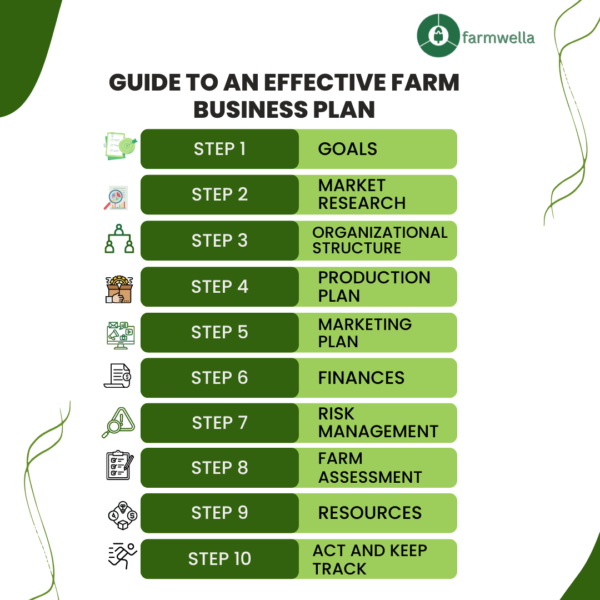
The saying goes, “Failing to plan is planning to fail,” and this rings true for businesses across all industries, including agriculture. Without a solid business plan, a farm business is more susceptible to failure.
Having a well-crafted business plan offers several benefits. It provides clarity and direction, helps with decision making, optimizes resource utilization, attracts funding and investment, and promotes adaptability and resilience.
In this article, we will go through the step-by-step guide that is needed to have a solid farm business plan.
No need to worry if you’re not familiar with business plans. I’ll break it down for you in simple terms. So, what exactly is a business plan?
A business plan is like a roadmap for your farm business. It’s a document that outlines your goals, strategies, and the steps you’ll take to achieve them. Think of it as a blueprint that guides you through challenges and helps you make informed decisions.
So, without wasting any more time, let’s dive right into how you can create a solid farm business plan for your venture.
How to Create an Outstanding Farm Business Plan
Before diving into the step-by-step guide for creating your farm business plan, let’s take a moment to explore the essential elements you need to know and have in place. These are the foundational components that will set you up for success in developing your plan and launching your farm business. Let’s check them out:

Step 1: Define Your Farming Goals and Objectives
When it comes to your farm business, it’s essential to have a clear vision of what you want to accomplish and set specific goals to achieve it. Here are a few key points to consider:
- Purpose: What is the purpose of your farm? Are you focused on providing fresh and organic produce to the local community, or are you aiming to specialize in a specific crop?
- Target Market: Who are your ideal customers? Identify the specific group of people or businesses that you will be catering to with your farm products. Understanding your target market helps you tailor your strategies accordingly.
- Financial Goals: Consider your financial aspirations. Are you looking to generate a certain level of income from your farm business? Do you have long-term growth objectives? Set measurable financial goals that align with your overall vision.
Step 2: Conduct Market Research
Before diving into your farm business, it’s crucial to do some market research. Here’s what you need to do:
- Understand Your Customers: Get to know the people who might be interested in buying your products. What are their preferences, needs, and buying habits? This knowledge will help you tailor your offerings to meet their demands.
- Learn from Others: Take a look at what other farmers in your area or similar markets are doing. How are they selling their products? What strategies are they using? Observing and learning from their successes and challenges can guide your own business decisions.
- Identify Your Unique Selling Points: Figure out what makes your farm stand out from the rest. Do you offer organic produce, specialty crops, or sustainable farming practices? Highlighting these unique aspects will attract customers and set you apart from the competition.
- Develop Effective Marketing Strategies: Armed with your market research, create a plan to promote and sell your products. Determine the best channels to reach your target customers, whether it’s through farmers’ markets, online platforms, or local stores. Craft compelling messages that resonate with your audience.
Step 3: Outline Your Farm's Organizational Structure
Now, let’s talk about how your farm will be organized. Follow these simple steps:
- Determine Your Business Structure: Decide if you’ll be the sole owner of your farm or if you’ll have partners or a team. Choose the business structure that best fits your needs, like being the only boss (sole proprietorship) or sharing responsibilities (partnership or corporation).
- Define Roles and Responsibilities: Clearly assign tasks to each person involved in your farm, such as managers, workers, and administrative staff. Make sure everyone knows what they’re responsible for and how their roles contribute to the farm’s success. This clarity helps your team work together efficiently.
- Promote Effective Communication: Encourage open and clear communication among your team members. This way, everyone can share ideas, solve problems, and stay on the same page. Good communication leads to better teamwork and smoother farm operations.
Step 4: Make a Detailed Production Plan
The production plan is all about how you’ll grow and raise your crops. Here’s what you need to do:
- Choose your focus: Decide which crops or animals you want to work with.
- Farming techniques: Figure out the best ways to grow your crops or raise your animals. Think about things like planting schedules, watering methods, and taking care of them.
- Gather what you need: Make a list of the things you’ll need, like seeds, fertilizers, and equipment.
- Plan smart: Consider important things like crop rotation (changing crops in different areas), and using irrigation systems for watering.
Step 5: Create a Winning Marketing Plan
Having a solid marketing plan is crucial for your farm’s success. Here’s how you can do it:
Know your customers: Identify the people you want to sell your products to. Think about their preferences and needs.
- Reach out: Find the best ways to connect with your customers. It could be through social media, local markets, or selling directly to restaurants and grocery stores.
- Price it right: Decide on the best pricing strategy for your products. Consider factors like production costs, market demand, and competition.
- Get noticed: Think about how you can make your farm stand out. Develop a unique brand and think about promotional activities to get people interested in what you offer.
- Stay flexible: Be open to trying different marketing approaches and adapting to what works best for your farm and target market.
Step 6: Plan Your Finances
Planning your farm’s finances is an important step to make sure you have enough money to start and run your business. Here’s what you need to do:
- Estimate your income: Think about how much money you expect to make from selling your products. This will help you understand if your farm can be profitable.
- Track your expenses: Keep track of all the money you spend on things like equipment, seeds, and labor. This will help you see how much it costs to run your farm.
- Balance your books: Create a balance sheet to see the overall financial health of your farm. This includes looking at your assets (like equipment and land) and your liabilities (like loans or debts).
- Break-even analysis: Figure out how much you need to sell in order to cover all your costs and start making a profit. This is called the break-even point.
Step 7: Manage Potential Risks
Running a farm comes with its fair share of risks. Here’s what you can do to protect your farm:
- Identify potential risks: Think about things that could go wrong, like bad weather, market changes, or pests. Knowing these risks will help you plan for them.
- Make a plan: Create a backup plan for each risk. For example, if there’s a drought, you could have a plan to use water more efficiently or switch to drought-resistant crops.
- Take preventive measures: Implement practices that reduce the chances of risks happening. This could include using natural pest control methods or practicing soil conservation.
- Get insurance: Consider getting insurance coverage to protect your farm against unexpected events. It can help you recover financially if something goes wrong.
Step 8: Assess Your Farm
To understand your farm better, let’s do a simple analysis called a SWOT analysis. It’s like taking a close look at your farm’s strengths, weaknesses, and the opportunities and challenges it faces. Here’s how you can do it:
- Strengths: Think about what your farm does really well. Maybe you have fertile soil, experienced workers, or access to a local market. These are the strengths that give you an advantage.
- Weaknesses: Identify areas where your farm could use improvement. It could be limited resources, outdated equipment, or a lack of marketing knowledge.
- Opportunities: Look for new chances to grow your farm. Are there any emerging trends in the market that you could tap into? Maybe there’s a demand for organic produce or agritourism. Finding these opportunities can help you expand your business.
- Challenges: Consider the obstacles you might face. It could be competition from other farms, changing weather patterns, or government regulations.
Step 9: Secure Funding if Needed
If you need financial help for your farm, it’s time to make a funding request. Here’s what you need to do:
- Determine the Amount: Figure out exactly how much money you need for your farm. Be specific and clear about the amount you require.
- Explain Your Plan: Outline a detailed plan on how you will use the funds. Will it be for buying new equipment, improving your farm’s infrastructure, or covering day-to-day expenses? Paint a clear picture of how the money will be put to good use.
- Highlight Existing Funding: If you’ve already secured some funding or investments, make sure to mention them. It shows that you have taken initiative and have support from other sources.
Step 10: Put Your Plan into Action and Keep Track
Now that your business plan is ready, it’s time to make things happen! Follow these steps to get started:
- Implement Your Strategies: Begin executing the strategies and actions outlined in your plan. Take the necessary steps to bring your farm business to life.
- Monitor Your Progress: Keep a close eye on how things are going. Regularly check your progress and see if you’re on track to meet your goals. This will help you identify any areas that need improvement.
- Review and Update: Remember, your business plan is not set in stone. Review it regularly and make updates as needed. Adapt to changes in the market and adjust your strategies accordingly.
- Measure Your Performance: Compare your actual results with the targets and milestones set in your plan. This will help you understand how well you’re doing and identify areas where you can improve.
Conclusion
Remember, seeking professional help is always a smart move if you encounter any difficulties in bringing your farm vision to life. Expert advice can offer valuable insights and support to ensure your plan is well-prepared and aligned with industry best practices.
Keep in mind that a well-prepared business plan is not just a document, but a powerful tool that sets your farm on the path to profitability and long-term sustainability. Regularly review and revise your plan to adapt to changing circumstances and seize new opportunities.